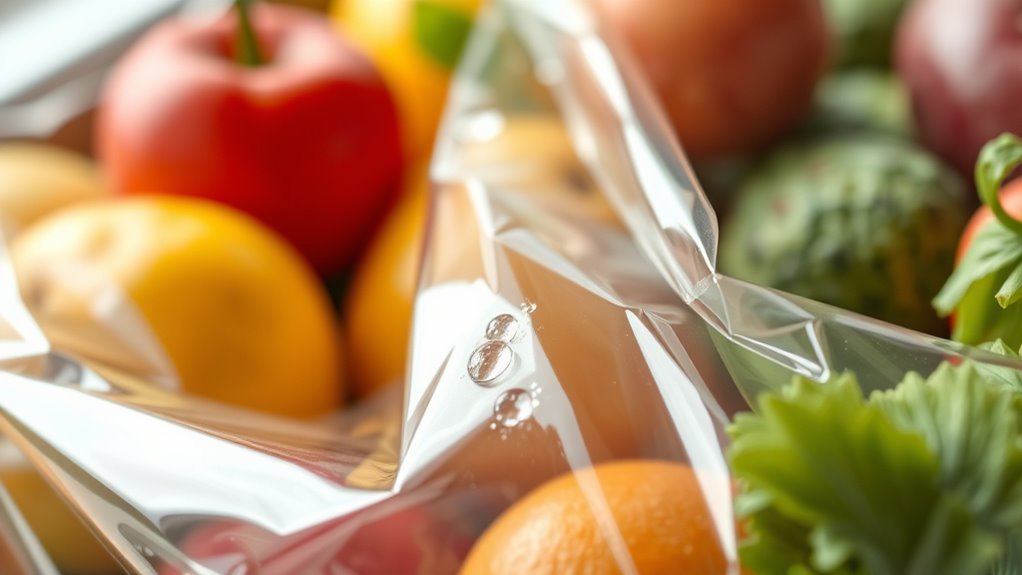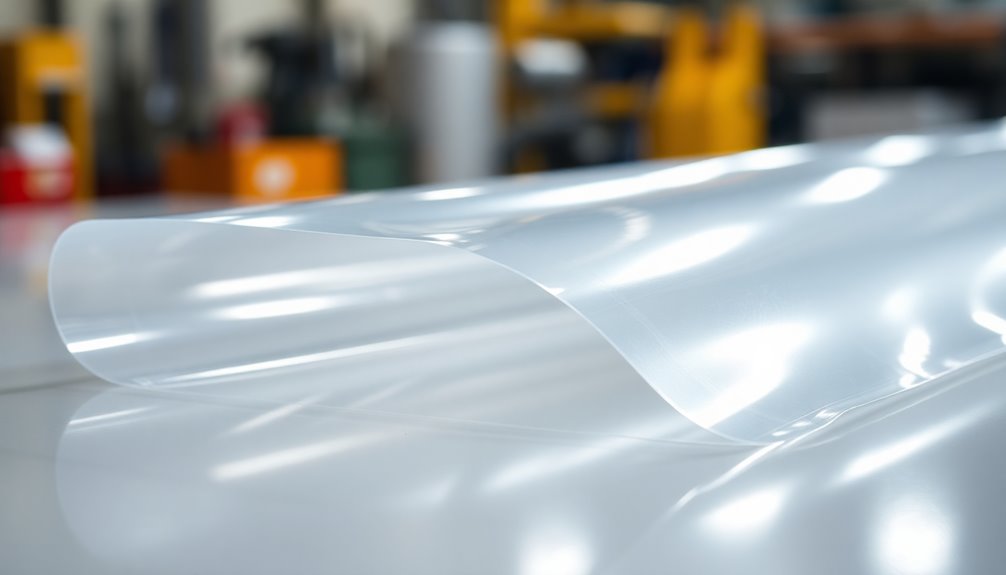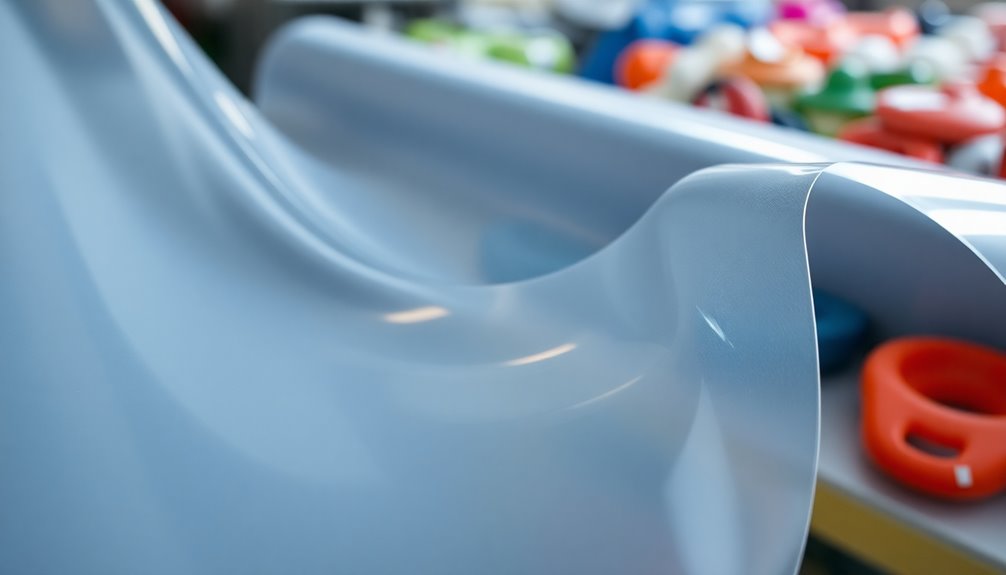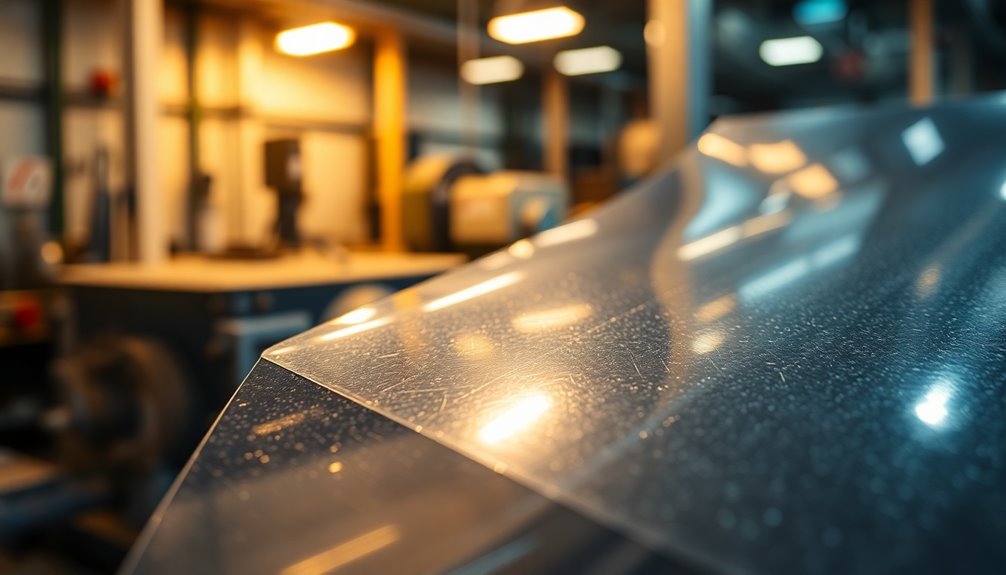Barrier films are specialized packaging materials that prevent moisture, oxygen, and light from reaching your products. They include metallic foils, polymer laminates, and metalized films, all designed to extend shelf life and keep items fresh. Choosing the right barrier film depends on your product’s needs, environmental exposure, and packaging process. As advances keep improving these materials, you’ll discover how they support industry growth and product protection—so keep exploring to learn more.
Key Takeaways
- Barrier films create protective layers that prevent oxygen, moisture, and light from reaching products, maintaining freshness.
- Materials like metallic foils and polymer laminates are key for blocking environmental factors that cause spoilage.
- Selecting the right barrier film depends on product type, environmental exposure, and packaging process compatibility.
- Advances in nanotechnology and biodegradable materials enhance barrier performance while supporting sustainability.
- Using high-quality barrier films extends shelf life, reduces preservatives, and ensures product quality over time.
Types of Barrier Films and Their Materials
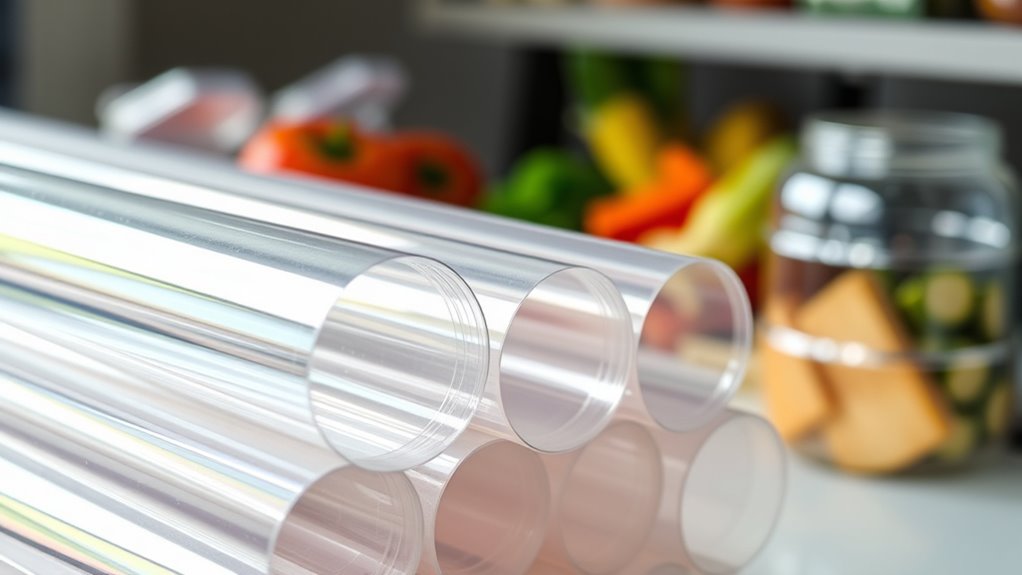
Barrier films come in various types, each designed to protect products by blocking moisture, oxygen, or light. Metalized films, such as metallic foils, provide an excellent barrier against light and gases, making them ideal for sensitive items. These foils are often combined with other materials to enhance durability and flexibility. Polymer laminates are another common type, consisting of multiple layers of polymers fused together to create a strong, moisture-resistant barrier. They can be tailored with different polymers to target specific protection needs, like oxygen or moisture barriers. Both metallic foils and polymer laminates are versatile options, allowing manufacturers to choose the best fit for their product’s shelf life and stability requirements. These materials play a vital role in extending freshness and maintaining product quality, especially when considering material customization to meet specific packaging needs. Additionally, advancements in barrier technology have enabled the development of films that offer even greater protection while maintaining flexibility and transparency. Manufacturing processes also contribute to improved product longevity, ensuring that packaged goods stay fresh for longer periods.
How Barrier Films Protect Product Quality
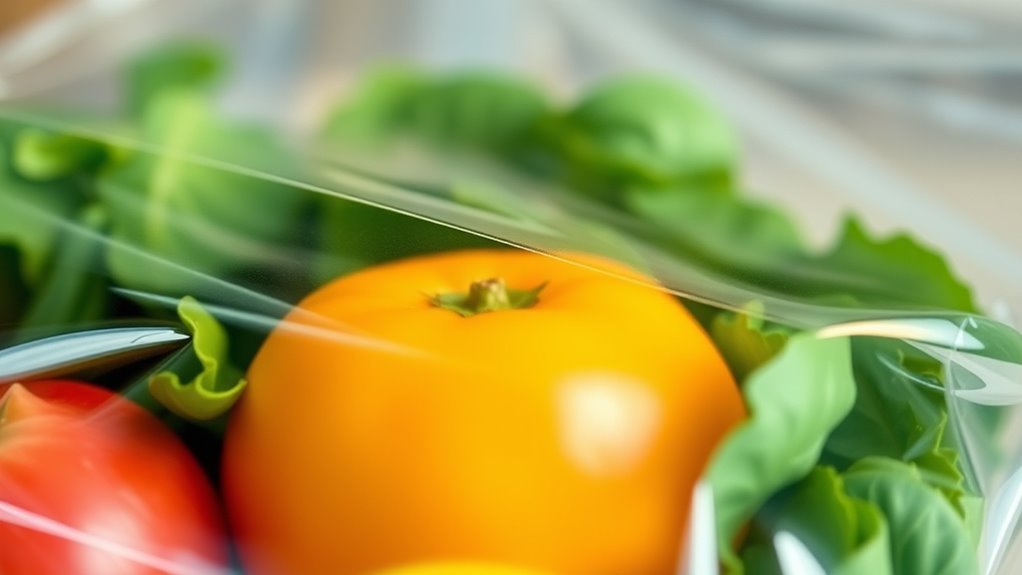
By using materials like metallic foils and polymer laminates, manufacturers create protective layers that prevent environmental factors from damaging products. These barrier films minimize oxygen permeability, slowing the entry of oxygen that can cause spoilage and oxidation. They also provide excellent moisture resistance, blocking humidity that could lead to mold, spoilage, or texture changes. This dual protection helps maintain your product’s freshness, flavor, and appearance longer. By controlling oxygen and moisture levels, barrier films reduce the need for preservatives and extend shelf life. Their ability to guard against these environmental factors ensures your products stay high-quality from packaging to consumption. Additionally, resilience built through innovation allows these films to adapt to evolving product requirements and consumer expectations, ensuring continued effectiveness. Understanding barrier properties is crucial to appreciating how these films preserve product integrity and meet consumer expectations for freshness and safety. Moreover, selecting the appropriate film material is essential for optimizing protective qualities tailored to specific products. Incorporating advanced manufacturing techniques further enhances the durability and functionality of barrier films, providing comprehensive protection. As research advances, new material compositions are being developed to improve barrier performance and sustainability.
Key Factors in Selecting Barrier Films
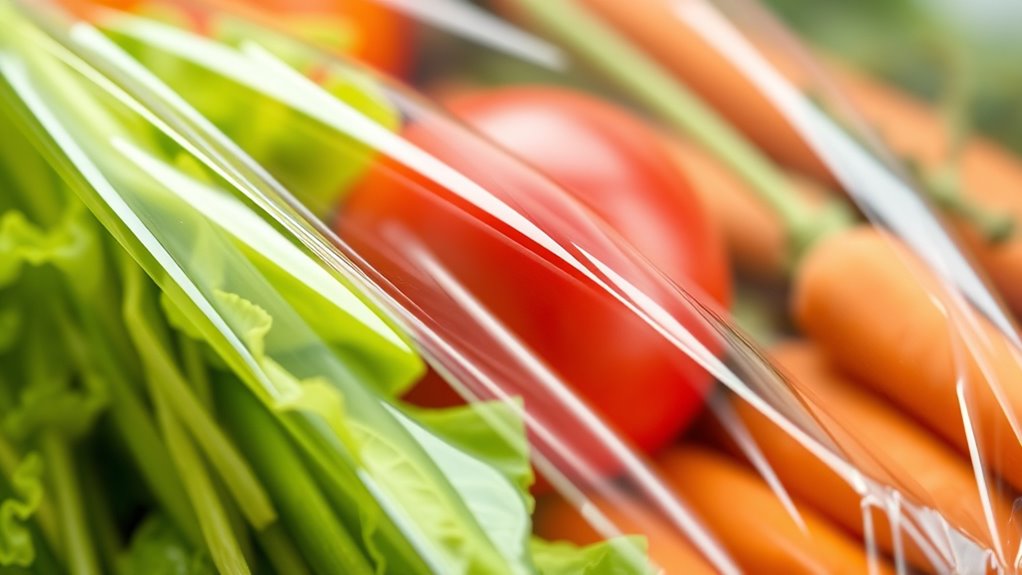
Choosing the right barrier film depends on understanding your product’s specific preservation needs and the environmental conditions it will face. Consider factors like moisture, oxygen, and light exposure. Aluminum foil offers excellent barrier properties against light and moisture, making it ideal for sensitive items. Oxygen scavengers help remove residual oxygen, extending shelf life. When selecting a film, evaluate compatibility with your packaging process and product type. Here’s a quick comparison:
| Feature | Aluminum Foil | Oxygen Scavengers | Typical Use |
|---|---|---|---|
| Barrier Against | Light, moisture | Oxygen | Fresh produce, baked goods |
| Flexibility | Rigid or flexible | Flexible | Snacks, meats |
| Cost | Higher | Moderate | Perishable items |
Focusing on the moisture barrier, especially for products sensitive to humidity, can significantly enhance shelf life. Additionally, understanding the packaging process ensures the chosen barrier film integrates seamlessly for optimal preservation. Incorporating innovative barrier materials can further improve product protection and extend shelf life. Staying informed about keto diet research and advancements can also inspire the development of new packaging solutions tailored to perishable health foods. Recognizing the importance of barrier properties can lead to better product longevity. Focus on these factors to make certain your product stays fresh longer.
Applications of Barrier Films Across Industries
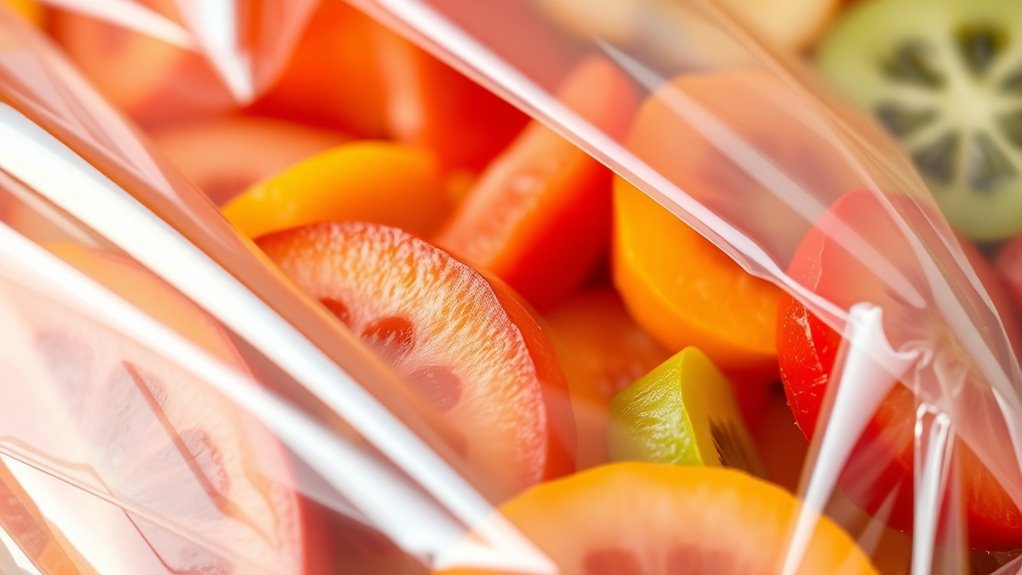
Barrier films play a essential role in preserving the quality and extending the shelf life of products across a wide range of industries. You’ll find them crucial in food packaging, where they control moisture and limit oxygen permeability to prevent spoilage and maintain freshness. In pharmaceuticals, barrier films protect sensitive medicines from moisture and oxygen, guaranteeing their efficacy. The electronics industry relies on these films to shield components from moisture, which could cause corrosion or malfunction. Similarly, in cosmetics, barrier films help preserve active ingredients by controlling environmental exposure. Their ability to reduce moisture ingress and oxygen permeability makes them versatile and critical for product stability. Additionally, advancements in appliance integration technology have led to the development of smarter barrier films that can adapt to changing environmental conditions, further enhancing product protection. The inclusion of antioxidant properties in some barrier films can also help in preventing the degradation of sensitive products. Furthermore, ongoing research into biodegradable materials is expanding the sustainability of barrier films, reducing environmental impact. Innovations in nanotechnology are contributing to the development of more effective barrier layers, offering enhanced protection while maintaining flexibility. By choosing the right barrier film, you ensure your products stay fresh, safe, and effective for longer periods.
Future Trends and Innovations in Barrier Packaging
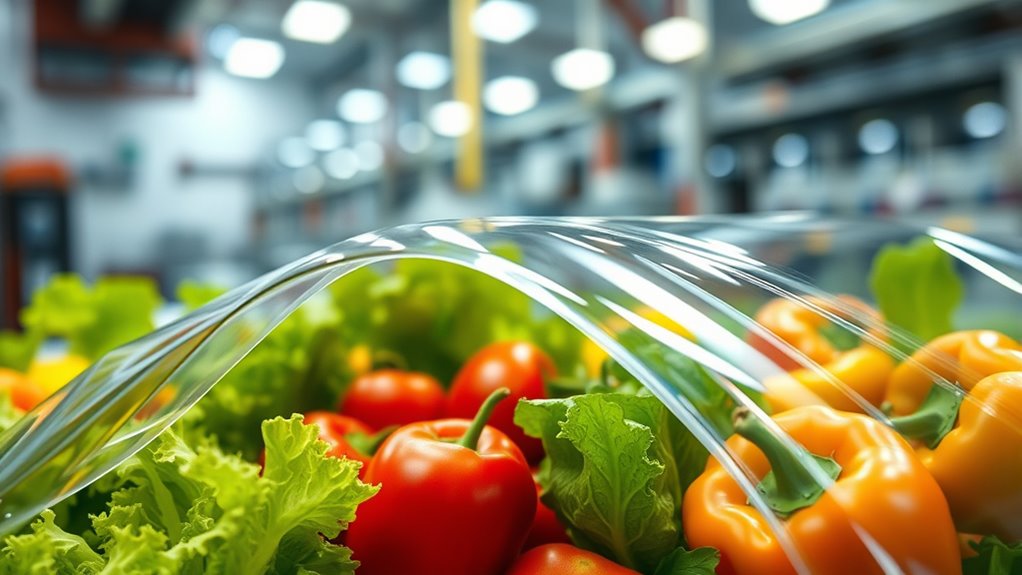
Advancements in material science and nanotechnology are driving innovative developments in barrier packaging. You can expect smarter packaging solutions that incorporate sensors to monitor freshness, detect spoilage, and provide real-time data. These smart packaging systems enhance product safety and reduce waste by alerting you to potential issues early. Additionally, the industry is moving toward biodegradable barriers that break down more sustainably, aligning with environmental goals. These eco-friendly materials maintain high barrier performance while minimizing ecological impact. Future trends also include lightweight, flexible films and multi-functional barriers that combine several protective features. As these innovations evolve, you’ll benefit from packaging that not only preserves product quality longer but also supports sustainability efforts, making your choices more environmentally conscious and efficient. Moreover, the integration of cost-effective materials will make these advanced barrier films more accessible for widespread use. Furthermore, manufacturing techniques are being refined to improve the performance and affordability of these cutting-edge films.
Frequently Asked Questions
How Long Can Barrier Films Effectively Preserve Product Freshness?
Barrier films can effectively preserve your product’s freshness for varying periods, depending on factors like the type of product and storage conditions. Typically, they extend shelf life by protecting against moisture, oxygen, and contaminants. You should consider ideal storage conditions, such as temperature and humidity, to maximize barrier film performance. With proper handling, these films help maintain quality and freshness, ensuring your product stays fresh longer and reduces waste.
Are Barrier Films Environmentally Friendly and Recyclable?
You might wonder if barrier films are eco-friendly and recyclable. While they help preserve freshness, many barrier films pose recycling challenges because they’re often made from multi-layer materials that are difficult to separate. However, eco-friendly options are emerging, using biodegradable or compostable materials. You should check local recycling guidelines, as not all facilities can process these films, making recycling a complex process despite their environmental potential.
Can Barrier Films Be Customized for Specific Product Needs?
When it comes to customization options, you’ll find barrier films are quite versatile. You can tailor them to your needs, incorporating product-specific barriers that suit different package requirements. This flexibility means you don’t have to settle for a one-size-fits-all solution. Manufacturers often offer options like varying thickness, material blends, and coatings, making it possible to create a barrier film perfectly suited for your product, ensuring freshness and extending shelf life.
What Are the Common Challenges in Using Barrier Films?
When you use barrier films, you often face challenges like ensuring material durability against moisture, oxygen, and light, which can compromise your product’s freshness. Manufacturing complexity can also be a hurdle, as producing high-quality films requires precise technology and consistent quality control. These issues may lead to increased costs and potential product spoilage, so you need to carefully select and handle barrier films to maintain effectiveness and avoid these common pitfalls.
How Do Barrier Films Impact the Cost of Packaging?
Think of barrier films as the gatekeepers of freshness that quietly influence your packaging costs. By choosing the right material, you open significant cost savings through improved durability and reduced waste. While premium films may seem pricier upfront, their ability to extend shelf life balances the scales. Your material selection acts like a master key, shaping the overall expense and ensuring your products stay fresh without breaking the bank.
Conclusion
Think of barrier films as your product’s sturdy shield in a bustling marketplace. They guard freshness like a vigilant gatekeeper, keeping out moisture, oxygen, and contaminants. By choosing the right type, you guarantee your products stay vibrant and appealing, no matter where they go. As technology advances, these films will become even smarter, like a loyal guardian with a keen eye, helping your products stay fresh, flavorful, and ready to impress every time.

